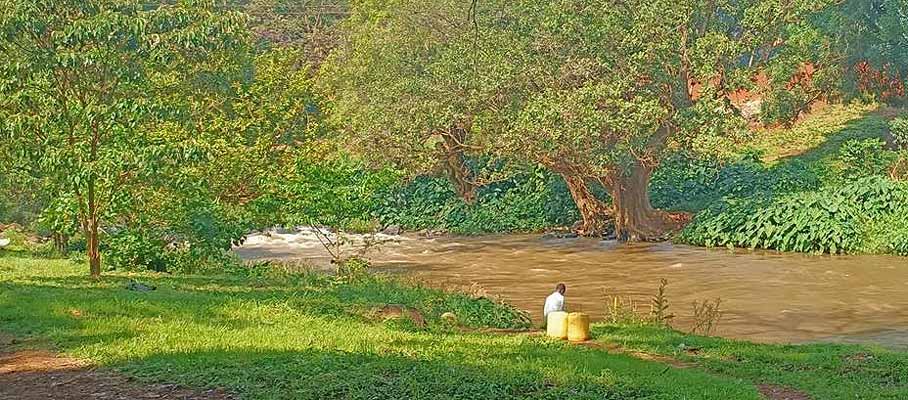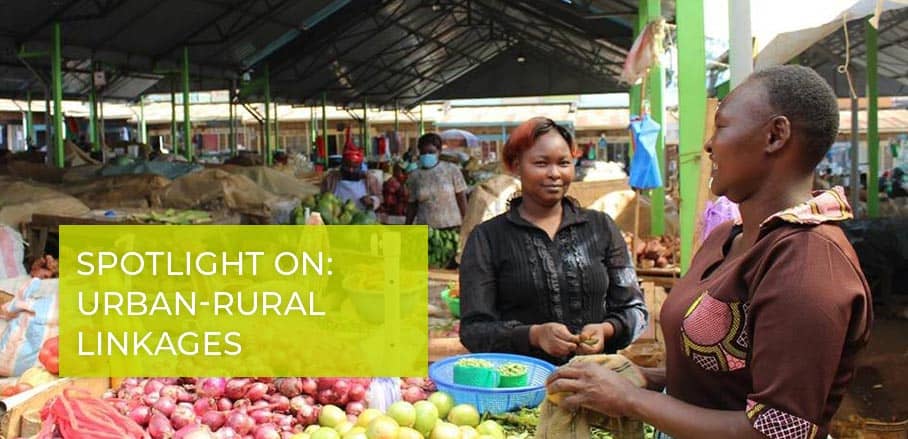Strengthening Urban-Rural Linkages in Kenya for Increased Resilience
Country-wide sustainable solutions can be assured only if regional connectivity and urban-rural linkages that support livelihoods in rural communities, towns, and smaller cities are considered alongside urban and regional growth strategies. Vassiliki Kravva and Ben Smith present an example from the UK-funded Sustainable Urban Economic Programme (SUED) in Kenya.
Regardless of location, climate zone, physical geography, and population and economic size, cities and towns rely on inputs from natural and social support systems within their wider urban catchment areas. Water, food, and biodiverse natural habitats are all critical resources, and risks to any of these, especially when they touch upon clean energy, water and/or food supply systems within wider urban catchments, can endanger the ability to deliver basic services and affordable food to urban populations.
Large and Small Urban Centres – Similar Challenges, Different Resources
Supporting the sustainable growth of smaller cities is therefore critical to an environment that can facilitate economic growth and diversity, create new jobs that will grow national output, and act as a disincentive for mass and uncontrolled migration into urban centres.
Interesting and innovative work in places as diverse as Cape Town and Caracas, London and Lusaka, has built a wealth of knowledge on how resilience and decarbonisation can be meaningfully integrated into effective urban planning agendas – but usually only for larger centres. All too often, building resilience and achieving low carbon development in small and medium-sized towns and cities is overlooked, leaving a significant gap in approach, ambition, and potential.
The economic output of smaller urban areas contributes significantly to national growth, too, and they also provide centres for social and cultural interaction and learning. These smaller centres face a similar set of climate challenges – but rarely receive the same level of resource, and do not have the governance to realistically address their specific set of issues.

Thiba river under bridge in Kutus town centre © Atikins
Devolution as an Approach to Strengthen Urban-Rural Linkages in Kenya
Devolution provides a significant opportunity to address historical imbalances in decision making, resource allocations, and financial support. In a Kenyan context, there is an opportunity for newly empowered local administrations to take ownership and redress lack of investment and promote activity within their jurisdictions.
How Does Climate Change Impact Both Rural and Urban Communities?
The economic importance of linking smaller urban centres with each other and with regional centres is especially vital in the agricultural sector, which accounts for 33 per cent of the country’s GDP. Small-scale farming accounts for roughly 75 per cent of the total agricultural output, and the sector provides work for nearly 70 per cent of the economically active population.
Climate change will undoubtedly impact most heavily the rural communities, whose livelihoods depend on this agricultural sector. But this will increasingly also impact urban populations, whose income, in part, results from urban markets activity, paratransit, and value addition activities such as domestic and international trade. Furthermore, an unsuccessful and endangered rural economy will encourage migration into major urban centres, many of which are already severely affected by infrastructure constraints. Productive urban-rural linkages in Kenya are thus crucial for both cities and rural communities alike.
Secondary cities in Kenya face a range of challenges:
- The country’s high dependency on rain-fed agriculture makes it vulnerable to flooding and droughts.
- Nutrient-rich foods such as fruit and vegetables are particularly vulnerable to post-harvest losses and are highly perishable. Estimates suggest as much as 50 per cent of crops harvested in Kenya are lost or destroyed.
- small-scale farmers have been facing various challenges (limited access to various resources such as technology and quality inputs, finance, storage, markets and information), resulting in chronic food crises.
- Supply chains linking rural and urban areas are fragile. Shocks such as the COVID-19 pandemic place an additional strain on systems that are already struggling to keep markets well-stocked and farmers supplied with the necessary base and raw materials. The poor condition of rural roads exacerbates the situation.
What Are Opportunities For Long-Term Prosperity?
Long term prosperity can be boosted by innovative solutions that conserve and improve efficiency in the use of water; boost agriculture yields, and treat natural habitats as valuable assets – especially high-value coastal areas.
The UK Government, through its Sustainable Urban Economic Programme (SUED) is supporting a suite of innovations and best practices in twelve Kenyan municipalities through a £70 million programme aimed at twelve fast growing municipalities to develop sustainable urban economic plans and attract investment for critical infrastructure and value chain projects. The goal is to integrate a market-based approach by helping to identify viable value chains and support critical climate-resilient infrastructure development that will maximise the economic potential of smaller cities and localities.
SUED has developed promising initiatives that are inclusive, support job creation, and that will strengthen resilience of cities and their urban catchments. Examples include:
- Introducing integrated nature-based approaches. In Kerugoya, future growth is highly dependent on the region’s water and natural resources, which are currently under significant stress. Pressures come from rapid and uncontrolled urbanisation, poor agricultural practices, pollution and degradation of resources, as well as climate change. A unique nature-based approach was introduced to Kerugoya to facilitate the sustainability of agri-processing activities by focusing on the protection of its unique water and natural resources and enhanced environmental resilience. This, in turn, will soon improve the health and wellbeing of all citizens and foster a growing community.
- Promoting value addition and job creation through circular economy. In Kisii, the focus was on creating value addition through processing and collection of previously overlooked waste and by-products such as banana fibres, which can be used to produce a range of products, including absorbent pads, rope, cardboard, tea bags, textiles, and matting. Other opportunities were posed by the use of sewage sludge to form charcoal briquettes, and the processing of abattoir waste to produce biogas, proteins for fertiliser/feeds, and filter cake.
- Creating supporting mechanisms to ensure sustainable and inclusive development. In most municipalities, an aggregation and collection system, supported by improved storage and road access, was proposed to improve linkages between rural growers and urban markets. These systems reduce post-harvest losses, provide a regular supply of produce to urban processing plants and markets, and address key climate risks relating to post-harvest losses and lack of access to market due to flooding. By rationalising the transport of goods to market and reducing the number of individual trips taken, aggregation systems can also significantly reduce the emissions associated with agricultural processing. It also provides a platform to supplement farmers’ incomes, stabilise prices, and support investment back into the sector.
The work of SUED over the last three years has reinforced both the critical role that resilient urban areas play in sustaining national and regional growth and the value that results from better connected smaller centres, especially those that look beyond city boundaries and create thriving, inclusive, and sustainable urban settlements outside traditional urban centres. There is now an opportunity for municipal governments to plan accordingly and attract investment to kickstart sustainable, inclusive urban development in a way that benefits all people and communities.
